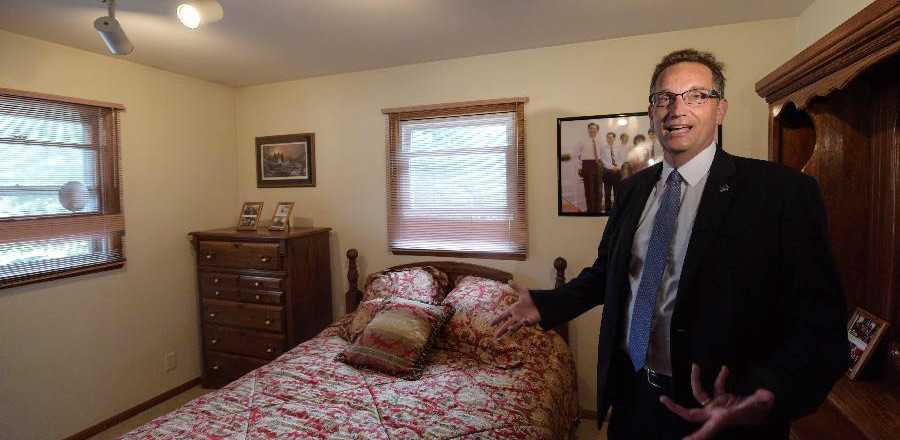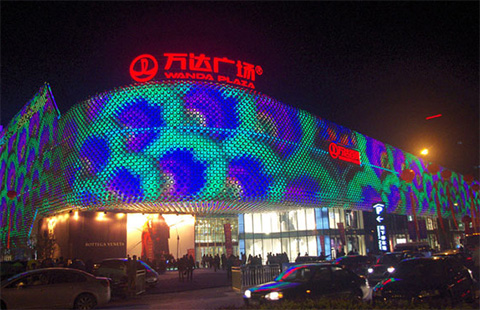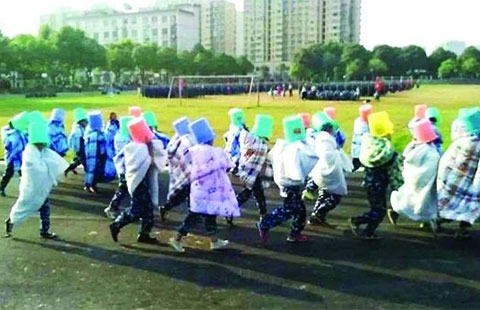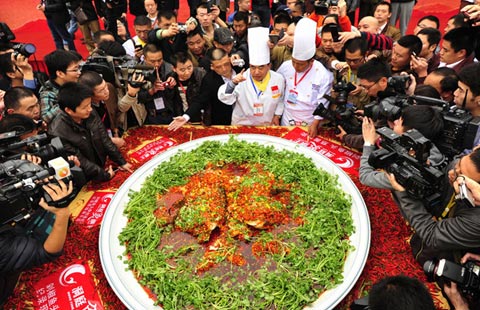'Beauty of Beijing's alleys akin to a wise, old person'
Updated: 2015-09-19 03:43
(China Daily USA)
|
||||||||
Aurora Bewicke, an American lawyer and artist, fell in love with the rough beauty of Beijing’s ancient alleyway neighborhoods when she first came to the city in 2001.
The cramped alleyways are created by rows of courtyard homes, where families traditionally lived in a communal style around a common yard. The homes, with tile roofs and dark brick walls, often are hundreds of years old and passed down through generations.
Bewicke, whose portrayals of Beijing and it’s alleyway culture are being displayed in a solo exhibition at the National Art Museum of China in Beijing, which opens on Sept 19 and lasts for one week, said her creative process draws directly from bits and pieces of local color. Her work is part collecting, part papier-mache, and part painting and drawing.
She said she creates her abstract works with materials such as magazines with colorful pictures, newspapers with content about important events, and fabrics of China’s traditional styles. She hunts amid the nooks and crannies of the Chinese capital to get the materials she needs.
Bewicke, 36, is a New York state native who has spent half of her life abroad, becoming an expat at age 18. She said she is attracted by a rough, unvarnished type of beauty. In addition to her eight years in China, she said she lived and thrived as a global nomad in Italy, Scotland, the Netherlands, Eritrea, Egypt and Kosovo.
She said she works for International Bridges to Justice, an international law NGO, dealing with financial cases, and all the clients she works with are Chinese.
“When I walk through the alleyways, I may see holes filled with a bag or a bottle, something tied together, wires are hanging up everywhere, the walls are quite dirty, and for me it evokes the sense of history.”
The beauty of the alleys, she said, is like that of the beautiful people when they get older and wiser. She has been living in Juer Hutong, an ancient alleyway near the center of Beijing, within the Second Ring Road.
Bewicke spoke at a recent lecture, Secrets of Hutongs, hosted by the US embassy at the Beijing American Center.
She said when she creates, “I pay more attention to my feelings toward things, trying to broaden the expression, not just copy down what I see”. She also adds bright colors and rough lines in the background.
“I do what comes into my mind at the moment when I’m creating. I just leave a couple of ‘info points’ in the picture so that people know what the picture is about.”
She said the “secrets” in her lecture had different meanings. When people stand away from the paintings, they see the abstract pictures that reflect Bewicke’s daily life in Beijing. When they come up close, they can read the printed text of articles to find out the local secrets on a particular day.
But as picturesque and evocative of history as the courtyard houses frequently are to foreigners, for many Chinese they are just old. It’s common for them to lack indoor plumbing, and many have been bulldozed to make way for shiny new buildings.
Ren Hong, like many of the Chinese audience who had a look at Bewicke’s paintings, said that she couldn’t share Bewicke’s feelings and deep love for the alleyways.
“Seeing many foreign artists draw the same side of China or Beijing, which are mostly similar, I don’t feel they are fresh or attractive. We might have gotten used to the environment.” Ren said.
Bewicke accepts negative comments without defensiveness.
“Artists nowadays make things that they think the audience want to see, so that their works can be sold for a better price. But I think we should be true to our beliefs,” she said. But not all locals are dismissive of her work. Wei Tao, also at Bewicke’s lecture, said he’s happy to know that foreigners are living in the city, appreciating the remaining ancient loveliness of the fast-modernizing Beijing, and reminding local people of the beauty around them.
“The young generation of Chinese may not show great interest in history or beauty, but they shouldn’t ignore the precious wealth they are so lucky to have,” said Wei.
Bewicke said she is open to new techniques, and would demonstrate working with elements like coffee at her exhibition, a medium that has become popular among artists in the US.
“If you come to the opening, I might draw you a portrait with soy sauce.” Bewicke said, making the audience laugh.
- UN chief: Those blocking fleeing refugees should 'stand in their shoes'
- Hungarian riot police detain migrants
- IOC announces five cities bid for 2024 summer Olympic
- Japan opposition to halt vote on security bills
- Japan protesters rally as security bills near passage
- Australia launches first air strikes against IS

 House showcasing Sino-American friendship open
House showcasing Sino-American friendship open
 Top 10 M&A deals between China and US in 2015
Top 10 M&A deals between China and US in 2015
 Messy dorm earns grueling punishinment for students
Messy dorm earns grueling punishinment for students
 Seven killed in landslide in SW China
Seven killed in landslide in SW China
 Chinese forces arrive in Malaysia for military exercise
Chinese forces arrive in Malaysia for military exercise
 Top 10 M&A deals between China and US in 2015
Top 10 M&A deals between China and US in 2015
 Delicious bites in record-breaking sizes
Delicious bites in record-breaking sizes
 An interview with Pilar Laguana: Introducing the island of Guam to China
An interview with Pilar Laguana: Introducing the island of Guam to China
Most Viewed
Editor's Picks

|

|

|

|

|

|
Today's Top News
President stresses Sino-US harmony
LA-Las Vegas link gets help
US CEOs give nod to BIT
Economy worries prompt Fed to hold rates steady
Google demos online marketing strategies to support Chinese SMEs
The ancient city takes a new route along the Silk Road
Villagers angry at verdict on fatal fire
Promoting the landscapes of China
US Weekly

|

|







